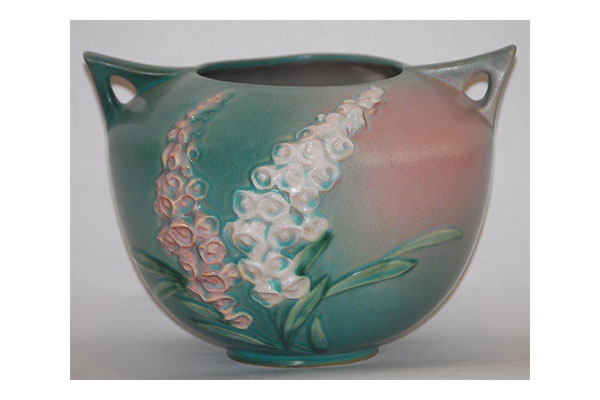
Perhaps the most obvious indicator of Roseville Foxglove pottery are the handles found on the majority of the pieces. When it was introduced in the early 1940s, words such as “enchanting” and “delicate” were used to describe it. Those words were certainly accurate as Roseville Foxglove remains a collector’s favorite.
According to Mark Bassett’s Introducing Roseville Pottery, the pink and blue glazes will bring in handsome prices. In total, there were fifty-five shapes (although only fifty-three are shown in its factory stock pages), including several bowls, jardinières and a lovely Foxglove conch shell. There also exists at least one Foxglove vase that has double handles designed into it. It measures 6” and narrows in circumference the closer to the neck it gets. It’s really a very pretty design and shape. Also note, many of the Roseville Foxglove pieces have bases. In fact, several pieces appear to be resting on these raised bases.
Also, note the varying heights within each piece. These artistic efforts really added to the overall beauty, as they add dimension and depth. Depending on which colors you find, the flowers will be colored accordingly. For instance, on the red pieces (actually, the color appears more of a deep brownish/red), the flowers will be shaded in pink. On the blue or green Foxglove pieces, you’ll notice flowers in pink, yellow or even white. Regardless, they’re all beautiful.
Here are a few more shapes you’ll find in the Roseville Foxglove pottery collection (These, of course, are in no way inclusive of the line as a whole):
- 8” cornucopia
- 8” basket
- 12” basket
- 10” tray
- 10” bowl
- 12” bowl
- Candlesticks
- Wall pockets
- Flower frog
- Bud vases
- Ewers
- Compote
As far as marking, typically, you’ll discover molded marks with “Roseville” in script along with the size and shape numbers.
Have your own collection of Roseville Foxglove pottery? We’d love to see it. Forward your photos to us. Also, don’t forget to follow us on Twitter and friend us on Facebook.


